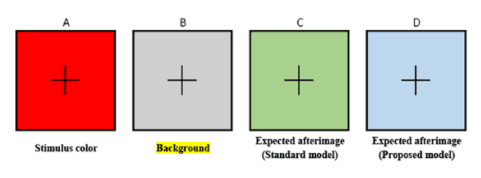The afterimages effect is a phenomenon that occurs when an image is displayed for a short time and then disappears, leaving a complementary color in the viewer's mind. The afterimage is produced due to the persistence of the visual sensation in the brain, even after the original image is no longer present. According to science, when an image of a certain color is displayed for a short period of time and then disappears, the complementary color of that image will appear as an afterimage. For example, if a red image is displayed and then disappears, a green afterimage will be perceived. The complementary colors that produce the strongest afterimages are red and green, blue and yellow, and cyan and magenta. This is due to the physiological properties of the color receptors in the eye and the way they process and transmit visual information to the brain.
Complementary afterimages are often modeled as illusory Hering opponent hues generated by the visual system as a result of adaptation. Yet, the empirical evidence suggests a different picture—Complementary afterimages are localized RGB filtered perception based on complementary color pairs. The article aims to bring to the fore an ongoing ambiguity about red/ green afterimages and then to address all cases of complementary afterimages. A simple model of afterimages based both on empirical data and the available literature is reconsidered and discussed: The afterimage color A depends both on the color stimulus S and on the ensuing background color B as estimated by the relation, A = B – kS.
